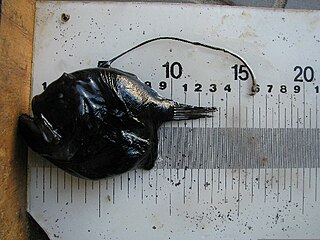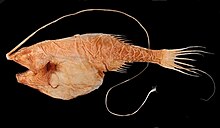
The footballfish form a family, Himantolophidae, of globose, deep-sea anglerfishes found in tropical and subtropical waters of the Atlantic, Indian, and Pacific Ocean. The family contains 23 species, all of which are classified in a single genus, Himantolophus.

Certaiidae, the warty sea devils, caruncled seadevils or seadevils, are a family of marine ray-finned fishes belonging to the suborder Ceratioidei, the deep-sea anglerfishes, in the anglerfish order Lophiiformes. The warty sea devils are sexually dimorphic with the small males being obligate sexual parasites of the much larger females. The fishes in this family are widely distributed from polar to tropical seas around the world.

Fanfins or hairy anglerfish are a family, Caulophrynidae, of marine ray-finned fishes within the order Lophiiformes, the anglerfishes. The fishes in this family are found almost around the world in the deeper, aphotic waters of the oceans.

Double anglers, the family Diceratiidae, is a small and little known family of rarely encountered marine ray-finned fishes belonging to the order Lophiiformes, the anglerfishes. The two genera and seven species of this family are found in the deeper waters of the tropical and subtropical Atlantic, Indian and Pacific Oceans. They are distinguished from other deep sea anglerfishes by the possession of a second bioluminescent cephalic spine. The fishes in this family were known only from metamorphosed females and the males were not described until 1983.

Oneirodidae, the dreamers are a family of marine ray-finned fishes belonging to the order Lophiiformes, the anglerfishes. These fishes are deepwater fishes found in the Atlantic, Indian and Pacific Oceans and it is the most diverse family of fishes in the bathypelagic zone.
Thaumatichthyidae, the wolftrap anglers, is a small family of marine ray-finned fishes, also called the wolftrap seadevils, classified within the suborder Ceratioidei, the deep-sea anglerfishes. They have distinctive upper jaws with movable premaxillaries that can be lowered to form a cage-like trap around the much shorter lower jaw.
Bertella is a monospecific genus of marine ray-finned fish belonging to the family Oneirodidae, the dreamers, a family of deep sea anglerfishes. The only species in the genus is Bertella idiomorpha and this can be distinguished from other members of the family by the structure of its hyomandibular bone.

The horned lantern fish or prickly seadevil is a species of marine ray-finned fish, it is the only species in the monotypic family Centrophrynidae. This species has a circumglobal distribution and is distinguished from other deep-sea anglerfishes by various characters including four pectoral radials, an anterior spine on the subopercular bone, and a short hyoid (chin) barbel in both sexes.

Gigantactis is a genus of marine ray-finned fish belonging to the family Gigantactinidae, the whipnose anglers. The fishes in this genus have a circumglobal distribution in the deep waters of the tropical and temperate zones of the Atlantic, Indian and Pacific Oceans.

Bufoceratias is a genus of marine ray-finned fishes belonging to the family Diceratiidae, the double anglers. Thee fishes in this genus are found i the Indian, Pacific and Western Atlantic Oceans.

Himantolophus groenlandicus, the Atlantic footballfish or Atlantic football-fish, is a species of marine ray-finned fish belonging to the family Himantolophidae, the footballfishes. This fish is found primarily in mesopelagic depths of the ocean. Despite its name, this species might not be restricted to the Atlantic Ocean, with its range possibly extending into the Indian Ocean and to the Pacific Ocean. It is found in tropical and temperate regions.

Ceratias is a genus of marine ray-finned fish belonging to the family Ceratiidae, the warty sea devils. This fishes in this genus are found throughpuit the world's oceans.

Diceratias is a genus of deep sea marine ray-finned fish belonging to the family Diceratiidae, the double anglers. These fishes are found in the Eastern Atlantic and Indo-Pacific regions.

Chaenophryne is a genus of marine ray-finned fish belonging to the family Oneirodidae, the dreamers, a family of deep sea anglerfishes. These predatory, deep-sea fishes are found in the tropical and subtropical oceans around the world. Like other deep-sea anglerfishes they are sexually dimorphic with the matamorphosed females dwarfing the metamorphosed males, the males are not sexual parasites.
Ctenochirichthys is a monospecific genus of marine ray-finned fish belonging to the family Oneirodidae, the dreamers, a family of deep sea anglerfishes. The only species in the genus is Ctenochirichthys longimanus is known only from two locations, on in the Atlantic Ocean and the other in the Western Pacific Ocean.
Dolopichthys is a genus of marine ray-finned fish belonging to the family Oneirodidae, the dreamers, a family of deep sea anglerfishes. These predatory, deep-sea fishes are found in the tropical and subtropical oceans around the world.
Microlophichthys is a genus of marine ray-finned fish belonging to the family Oneirodidae, the dreamers, a family of deep sea anglerfishes. The species in this genus are found in the tropical and subtropical parts of the Atlantic, Indian and Pacific Oceans.

Oneirodes is a genus of is a genus of marine ray-finned fish belonging to the family Oneirodidae, the dreamers, a family of deep sea anglerfishes. These predatory, deep-sea fishes are found around the world. This is the type genus, and the most speciose genus, of the family Oneirodidae. They are sexually dimorphic but, like most taxa within their family, the small males are free living and are not sexual parasites on the larger females. Only the females are used to identify the species in this genus as no species specific charaxcters have been found for males.

Pentherichthys is a monospecific genus of marine ray-finned fish belonging to the family Oneirodidae, the dreamers, a family of deep-sea anglerfishes. The only species in the genus is Pentherichthys atratus which is found in the bathypelagic zones of the tropical and subtropical Atlantic, Indian and Pacific Oceans. The males of this species are dwarfed and are not parasitic on the females.

Ceratioidei, the deep-sea anglerfishes or pelagic anglerfishes, is a suborder of marine ray-finned fishes, one of four suborders in the order Lophiiformes, the anglerfishes. These fishes are found in tropical and temperate seas throughout the world. One of the better known traits of the deep-sea anglerfishes is their extreme sexual dimorphism where the males are many times smaller than the females, the males seek out females and use their sharp teeth to clamp onto the females where he remains for the rest of his life, in some species he becomes part of the female. This is the only known natural example of a process called parabiosis. Another common trait of deep-sea anglerfishes is that they use bioluminescence on their esca to attract prey in the darkness of the deep oceans they inhabit.













